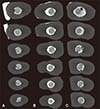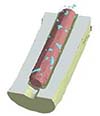1. Zicari F, Couthino E, De Munck J, Poitevin A, Scotti R, Naert I, Van Meerbeek B. Bonding effectiveness and sealing ability of fiber-post bonding. Dent Mater. 2008; 24:967–977.
2. Baba NZ, Golden G, Goodacre CJ. Nonmetallic prefabricated dowels: a review of compositions, properties, laboratory, and clinical test results. J Prosthodont. 2009; 18:527–536.
3. Spazzin AO, Galafassi D, de Meira-Júnior AD, Braz R, Garbin CA. Influence of post and resin cement on stress distribution of maxillary central incisors restored with direct resin composite. Oper Dent. 2009; 34:223–229.
4. Goracci C, Grandini S, Bossù M, Bertelli E, Ferrari M. Laboratory assessment of the retentive potential of adhesive posts: a review. J Dent. 2007; 35:827–835.
5. Boschian Pest L, Cavalli G, Bertani P, Gagliani M. Adhesive post-endodontic restorations with fiber posts: push-out tests and SEM observations. Dent Mater. 2002; 18:596–602.
6. Furuya Y, Huang SH, Takeda Y, Fok A, Hayashi M. Fracture strength and stress distributions of pulpless premolars restored with fiber posts. Dent Mater J. 2014; 33:852–858.
7. Ferrari M, Cagidiaco MC, Goracci C, Vichi A, Mason PN, Radovic I, Tay F. Long-term retrospective study of the clinical performance of fiber posts. Am J Dent. 2007; 20:287–291.
8. Bergoli CD, Amaral M, Boaro LC, Braga RR, Valandro LF. Fiber post cementation strategies: effect of mechanical cycling on push-out bond strength and cement polymerization stress. J Adhes Dent. 2012; 14:471–478.
9. de Durâo Mauricio PJ, González-López S, Aguilar-Mendoza JA, Félix S, González-Rodríguez MP. Comparison of regional bond strength in root thirds among fiber-reinforced posts luted with different cements. J Biomed Mater Res B Appl Biomater. 2007; 83:364–372.
10. Lundström TS, Gebart BR. Influence from process parameters on void formation in resin transfer molding. Polymer Composites. 1994; 15:25–33.
11. Drummond JL. Degradation, fatigue, and failure of resin dental composite materials. J Dent Res. 2008; 87:710–719.
12. D'Arcangelo C, Cinelli M, De Angelis F, D'Amario M. The effect of resin cement film thickness on the pullout strength of a fiber-reinforced post system. J Prosthet Dent. 2007; 98:193–198.
13. Rasimick BJ, Wan J, Musikant BL, Deutsch AS. A review of failure modes in teeth restored with adhesively luted endodontic dowels. J Prosthodont. 2010; 19:639–646.
14. Grandini S, Goracci C, Monticelli F, Borracchini A, Ferrari M. SEM evaluation of the cement layer thickness after luting two different posts. J Adhes Dent. 2005; 7:235–240.
15. Nazari A, Sadr A, Shimada Y, Tagami J, Sumi Y. 3D assessment of void and gap formation in flowable resin composites using optical coherence tomography. J Adhes Dent. 2013; 15:237–243.
16. Milutinović-Nikolić AD, Medić VB, Vuković ZM. Porosity of different dental luting cements. Dent Mater. 2007; 23:674–678.
17. Geirsson J, Thompson JY, Bayne SC. Porosity evaluation and pore size distribution of a novel directly placed ceramic restorative material. Dent Mater. 2004; 20:987–995.
18. del Valle S, Miño N, Muñoz F, González A, Planell JA, Ginebra MP. In vivo evaluation of an injectable Macroporous Calcium Phosphate Cement. J Mater Sci Mater Med. 2007; 18:353–361.
19. Jung M, Lommel D, Klimek J. The imaging of root canal obturation using micro-CT. Int Endod J. 2005; 38:617–626.
20. Keleş A, Alcin H, Kamalak A, Versiani MA. Micro-CT evaluation of root filling quality in oval-shaped canals. Int Endod J. 2014; 47:1177–1184.
21. Keles A, Ahmetoglu F, Uzun I. Quality of different guttapercha techniques when filling experimental internal resorptive cavities: a micro-computed tomography study. Aust Endod J. 2014; 40:131–135.
22. Swain MV, Xue J. State of the art of Micro-CT applications in dental research. Int J Oral Sci. 2009; 1:177–188.
23. Kato A, Ohno N. Construction of three-dimensional tooth model by micro-computed tomography and application for data sharing. Clin Oral Investig. 2009; 13:43–46.
24. Keleş A, Alcin H, Kamalak A, Versiani MA. Oval-shaped canal retreatment with self-adjusting file: a micro-computed tomography study. Clin Oral Investig. 2014; 18:1147–1153.
25. Malkoç MA, Sevimay M, Tatar İ, Çelik HH. Micro-CT Detection and Characterization of Porosity in Luting Cements. J Prosthodont. 2015; 24:553–561.
26. Nomoto R, McCabe JF. Effect of mixing methods on the compressive strength of glass ionomer cements. J Dent. 2001; 29:205–210.
27. Asheibi F, Qualtrough AJ, Mellor A, Withers PJ, Lowe T. Micro-CT evaluation of the effectiveness of the combined use of rotary and hand instrumentation in removal of Resilon. Dent Mater J. 2014; 33:1–6.
28. Ng YL, Mann V, Rahbaran S, Lewsey J, Gulabivala K. Outcome of primary root canal treatment: systematic review of the literature - Part 2. Influence of clinical factors. Int Endod J. 2008; 41:6–31.
29. Maccari PC, Conceição EN, Nunes MF. Fracture resistance of endodontically treated teeth restored with three different prefabricated esthetic posts. J Esthet Restor Dent. 2003; 15:25–30.
30. Barcellos RR, Correia DP, Farina AP, Mesquita MF, Ferraz CC, Cecchin D. Fracture resistance of endodontically treated teeth restored with intra-radicular post: the effects of post system and dentine thickness. J Biomech. 2013; 46:2572–2577.
31. Kainose K, Nakajima M, Foxton R, Wakabayashi N, Tagami J. Stress distribution in root filled teeth restored with various post and core techniques: effect of post length and crown 3D micro-CT analysis of void formations and push-out bonding strength of resin cements used for fiber post cementation height. Int Endod J. 2015; 48:1023–1032.
32. Baudin C, Osorio R, Toledano M, de Aza S. Work of fracture of a composite resin: fracture-toughening mechanisms. J Biomed Mater Res A. 2009; 89:751–758.
33. Serafino C, Gallina G, Cumbo E, Ferrari M. Surface debris of canal walls after post space preparation in endodontically reated teeth: a scanning electron microscopic study. Oral Surg Oral Med Oral Pathol Oral Radiol Endod. 2004; 97:381–387.
34. Pereira JR, Lins do, Ghizoni JS, Lorenzoni FC, Ramos MB, Dos Reis. Push-out bond strengths of different dental cements used to cement glass fiber posts. J Prosthet Dent. 2013; 110:134–140.
35. Kalkan M, Usumez A, Ozturk AN, Belli S, Eskitascioglu G. Bond strength between root dentin and three glass-fiber post systems. J Prosthet Dent. 2006; 96:41–46.
36. Chen Q, Cai Q, Li Y, Wei XY, Huang Z, Wang XZ. Effect on push-out bond strength of glass-fiber posts functionalized with polydopamine using different adhesives. J Adhes Dent. 2014; 16:177–184.













 PDF
PDF ePub
ePub Citation
Citation Print
Print



 XML Download
XML Download